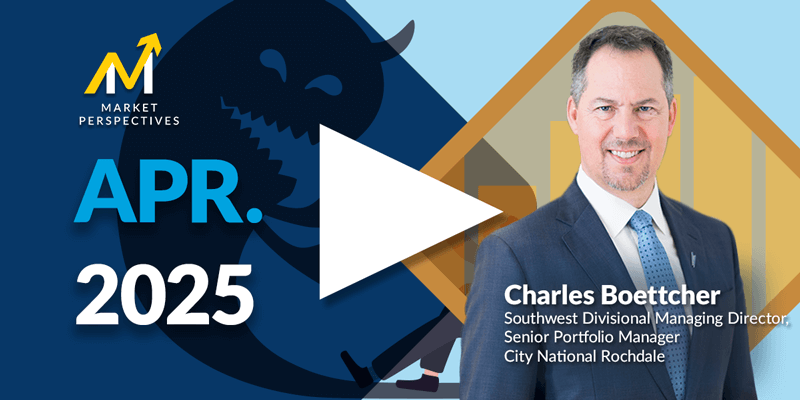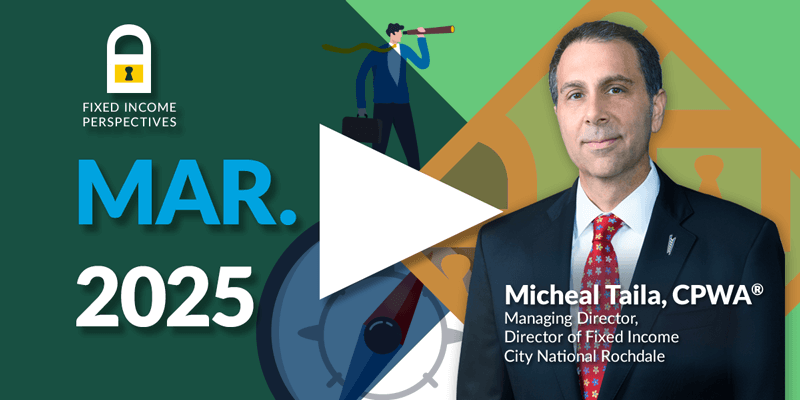-
Economic Perspectives
Consumer Sentiment: Pay attention to what they do, not what they say
March 2025
- Filename
- Economic Perspectives MARCH 2025.pdf
- Format
- application/pdf
TRANSCRIPT
Well, one thing is obvious. The new administration in Washington is moving quickly to change many aspects of how the federal government will work with its day-to-day business, the American public and the relationship that it has with longtime allies and trading partners.
As the sentiment data shows, these actions are severely impacting how the public views the economy. The weak sentiment data has caught the eyes of many economists, analysts and strategists, who are trying to determine whether they mean a change in the pace of economic growth, or just a short-term interruption.
For decades, consumer sentiment and consumer spending moved in tandem. When people felt unsure about the economy, they tended to spend less, and vice versa. But, in the last few business cycles, that link between sentiment and spending broke down.
Just a note for today: We’ll be examining the University of Michigan’s consumer sentiment index charts. They’re often considered the primary sources of data that represents the attitudes and concerns of the American public’s assessment of consumer’s views of business, personal finance and spending.
It’s used as one of the ten indicators of the popular measurement of economic growth, called the leading economic indicators. The survey is updated monthly, and based on telephone interviews that have 50 questions.
UMich: Current Economic Conditions
index value, not seasonally adjusted

Data current as of March 26, 2025
Source: University of Michigan Surveys of Consumers
Information is subject to change and is not a guarantee of future results.
Chart 1, 1:42– This consumer sentiment chart goes back to 1980. As you can see, the current level of sentiment, at 57.9, is hovering around all-time lows.
UMich: Consumer Sentiment
percentage points, 3-month change

Data current as of March 26, 2025
Source: University of Michigan Surveys of Consumers
Information is subject to change and is not a guarantee of future results.
Chart 2, 1:53– Here in this chart, which I admit is very busy, the vertical line measures the three-month change in the sentiment index. You can see that the 16-point drop in the index is one of the fastest declines. So, from the first two charts, we can see that the deterioration has been swift and severe.
UMich: Current Economic Conditions
index value, not seasonally adjusted

Data current as of March 26, 2025
Source: University of Michigan Surveys of Consumers
Information is subject to change and is not a guarantee of future results.
Chart 3, 2:13– Among the significant concerns consumers are focused on are the economic conditions, which are hovering near all-time lows.
UMich: News Related to Government Economic Policies (% Bal)
index value, not seasonally adjusted

Data current as of March 26, 2025
Source: University of Michigan Surveys of Consumers
Information is subject to change and is not a guarantee of future results.
Chart 4, 2:22– Much of that concern can be seen in the severe 35-point plunge in the news category related to government economic policies.
UMich: Opinion of Government's Economic Policy Index
index value, not seasonally adjusted

Data current as of March 26, 2025
Source: University of Michigan Surveys of Consumers
Information is subject to change and is not a guarantee of future results.
Chart 5, 2:31– This chart is a broader category of the opinion of the government economic policies.
In this chart, the shaded area indicates the overall view, which stands at a score of 57, the lowest level since 2011. Back then, the economy was recovering from the global financial crisis, and there were debt ceiling issues in the news. The dark-blue line, which measures that the government is doing a good job, has fallen to 19. The light-blue line showing that the government is doing a lousy job has increased to 62. That’s the highest on record. It’s ten points higher than the previous record, which was back in the 1990s.
UMich: Expected Change in Unemployment During Next Year
index value, not seasonally adjusted

Data current as of March 26, 2025
Source: University of Michigan Surveys of Consumers
Information is subject to change and is not a guarantee of future results.
Chart 6, 3:13– This chart shows the changes in the unemployment rate over the next year. It’s at 50, one of the lowest levels on record.
UMich: Expected Change in Prices During the Next Year
%, not seasonally adjusted

Data current as of March 26, 2025
Source: University of Michigan Surveys of Consumers
Information is subject to change and is not a guarantee of future results.
Chart 7, 3:21– Now, we will take a look at the attitude of hard economic data.
Another concern is inflation. This chart measures the expected change in inflation over the next year. You can see the current increase is at a level close to the recent high of April 2022. Back then, the consumer price index was soon to peak at 9.1%. Those are levels well above the Fed’s target of 2%.
UMich: Expected Change in Prices During the Next 5-10 Years
%, not seasonally adjusted

Data current as of March 26, 2025
Source: University of Michigan Surveys of Consumers
Information is subject to change and is not a guarantee of future results.
Chart 8, 3:49– This chart measures the longer-term expectation for inflation five to 10 years from now. Historically, this is not as volatile as the one year forward rate we just looked at, but here, you can see a significant increase in the past few months.
At a reading of 3.9%, it’s at the highest level since the 1990s. This report is more important because it’s a bigger concern for the Fed. It believes that consumers who think inflation will stay high for a long period of time will alter their spending habits.
CEO Confidence in the Economy Index: 1-year from Now
%, not seasonally adjusted

Data current as of March 26, 2025
Source: University of Michigan Surveys of Consumers
Information is subject to change and is not a guarantee of future results.
Chart 9, 4:22– It’s not just ordinary people who are concerned, because CEOs are, too. This chart shows the chief executive officer’s confidence in the level of the economy over the next year.
There’s been a two-point drop in this past month, putting it below the 2022 low, and at a level not seen since the economy emerged from the global financial crisis. This is an essential report since CEOs’ assessments of economic risk determine hiring, investments and other major spending decisions at the corporate level.
Last month, this index was above the long-term average, but now it is below.
UMich: Consumer Sentiment by Income Bracket
index value, not seasonally adjusted

Data current as of March 26, 2025
Source: University of Michigan Surveys of Consumers
Information is subject to change and is not a guarantee of future results.
Chart 10, 5:01– The decline in sentiment is happening among all of the income groups. This is an important issue. In 2024, those at the higher end of the income spectrum started to separate from middle- and lower-income groups. Before that, all three groups had very close readings.
Let me take a little extra time to review this slide. It’s important.
Economists like to call business cycles by a letter that they may represent in a chart. There’s the classic V-shaped business cycle, in which there’s a quick reversal following a rapid decline in GDP growth. So, the chart looks like the letter “V.” The U-shaped cycle has a rapid decline, but a long period of slow growth before rebounding. We appear to be in a K-shaped economic recovery.
Those at the upper end of the income spectrum are enjoying many of the economy's benefits. They probably own financial assets that have significantly appreciated in value over the past few years. They probably own a home. Those prices have gone up, too.
Furthermore, if they have a mortgage on their home, they probably refinance it during the period of low interest rates, so their monthly liability has fallen. Economically speaking, they’re in good shape. They represent the upper vector in the letter “K.”
However, those at the lower end of the income spectrum do not share those same benefits. They probably rent instead of owning, and rental costs have been appreciating faster than overall inflation.
Furthermore, a larger share of their income is spent on essential items, like food or operating a car. All of these have been appreciating in price faster than overall inflation, too. This cohort’s quality of life is not improved, and it may be worse. They are seen in the lower vector of the letter “K,” and this can be seen in the next chart.
CPI: Living Cost
%, indexed at 0.0 on January 2022 as of February 2025

Data current as of March 26, 2025
Source: Bureau of Labor Statistics
Information is subject to change and is not a guarantee of future results.
Chart 11, 6:57– The shaded area shows the overall growth in CPI. The lines show the aggregate change in the price of key expenditures. All of them have experienced price growth greater than the overall inflation rate, putting a burden on those households.
Share of Spending by Income Group
% of total

Data current as of March 26, 2025
Source: University of Michigan Surveys of Consumers
Information is subject to change and is not a guarantee of future results.
Chart 12, 7:14– So, why has the economy performed so well, when two out of three cohorts are being negatively impacted by certain economic events? The reason can be seen in this chart from Moody’s Analytics. Those in the top 40th percentile of income do 80% of the spending, while those in the bottom 40th percentile do just 9%.
Over the past few years, the wealth creation has given those at the higher end of the income spectrum the means and confidence to spend money, which has driven the economy. Remember, consumer spending is about two-thirds of GDP growth.
UMich: Consumer Sentiment
index value, not seasonally adjusted

Data current as of March 26, 2025
Source: University of Michigan Surveys of Consumers
Information is subject to change and is not a guarantee of future results.
Chart 13, 7:53– Let’s go back to the original chart of consumer sentiment. The current reading of 57.9 is near the record lows of 50.0 recorded back in June of 2022. Back then, the Fed started to raise interest rates. The stock market had traded off over the previous few months. Food prices were high. They were up almost 14% year over year when the average increases were around 3% to 4%. And also, gasoline prices hit a cycle high. Consumers were upset that all these changes were rapidly put upon them.
But what has happened to the economy following that low reading in June of 2022? Well, 7 million people have been added to the payroll. GDP growth has averaged 2.9%, driven heavily by consumer spending. This, despite the fact that the Fed has raised interest rates by three percentage points. The economic performance since 2022 has been remarkable. Why did it happen? Well, it’s due to the strong macroeconomic fundamentals of the economy.
The same thing is occurring right now. The fear of higher prices due to tariffs and the possible trade war is upsetting many people, but we still have strong fundamentals. The unemployment rate is low, household balance sheets are strong, and income gains are more substantial than inflation.
Welcome to the uncertainty bandwagon.
Keep in mind that sentiment data is categorized by economists as soft data, as opposed to hard data. I often joke that an example of soft data is what my teenage sons tell me on Friday night about their homework plans for the weekend. On Sunday night, I get the hard data. I find out exactly what was accomplished. Sentiment tells us what people think and feel. It’s soft data. Reports like labor or retail sales tell us precisely what consumers are actually doing, and that’s what goes into the GDP calculation. Our view is that the macroeconomic drivers will determine the direction of the economy.
The unemployment rate is very low. Household balance sheets are very strong, and income is growing faster than inflation. But there are some unanswered questions that are increasing the uncertainties surrounding the steepness of the upward trajectory that we see in the economy.
The question is, “How much of Washington's talk and actions will impact the solid economy?” We do not know the answer to that. Nobody does. We do not expect any of the actions to derail the economic expansion.
There’ll probably be some immediate impact, maybe a slower pace of hiring or spending, or maybe even investment, or maybe not.
Once we know the road map that the administration has planned, private enterprise can focus on finding ways to grow the economy. We just need to get past this period of uncertainty, just like we did in June 2022.
Important Information
The information presented does not involve the rendering of personalized investment, financial, legal, or tax advice. This presentation is not an offer to buy or sell, or a solicitation of any offer to buy or sell any of the securities mentioned herein.
Certain statements contained herein may constitute projections, forecasts and other forward-looking statements, which do not reflect actual results and are based primarily upon a hypothetical set of assumptions applied to certain historical financial information. Viewers are cautioned that such forward-looking statements are not a guarantee of future results, involve risks and uncertainties, and actual results may differ materially from those statements. Certain information has been provided by third-party sources and, although believed to be reliable, it has not been independently verified and its accuracy or completeness cannot be guaranteed.
Any opinions, projections, forecasts, and forward-looking statements presented herein are valid as of the date of this video’s distribution and are subject to change.
Past performance or performance based upon assumptions is no guarantee of future results.
All investing is subject to risk, including the possible loss of the money you invest. As with any investment strategy, there is no guarantee that investment objectives will be met and investors may lose money. Diversification does not ensure a profit or protect against a loss in a declining market.
City National Rochdale, LLC is an SEC-registered investment adviser and wholly-owned subsidiary of City National Bank. Registration as an investment adviser does not imply any level of skill or expertise. City National Bank is a subsidiary of the Royal Bank of Canada.
© 2025 City National Bank. All rights reserved.
NON-DEPOSIT INVESTMENT PRODUCTS ARE: • NOT FDIC INSURED • NOT BANK GUARANTEED • MAY LOSE VALUE
Stay Informed.
Get our Insights delivered straight to your inbox.
Put our insights to work for you.
If you have a client with more than $1 million in investable assets and want to find out about the benefits of our intelligently personalized portfolio management, speak with an investment consultant near you today.
If you’re a high-net-worth client who's interested in adding an experienced investment manager to your financial team, learn more about working with us here.



